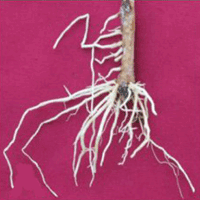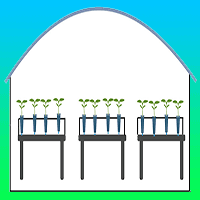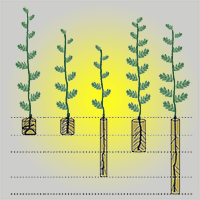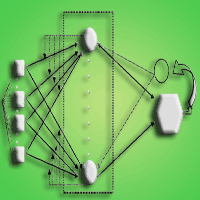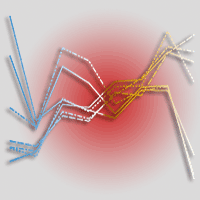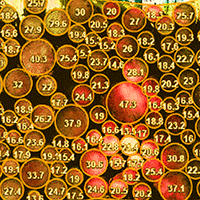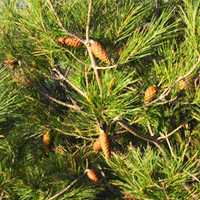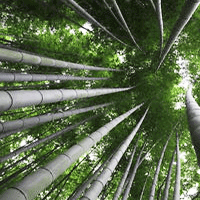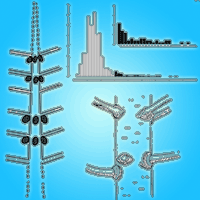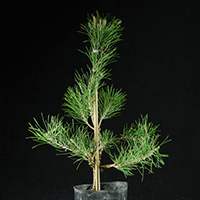
Effect of family, crown position, number of winter buds, fresh weight and the length of needle on rooting ability of Pinus thunbergii Parl. cuttings
Tetsuji Hakamata (1) , Yuichiro Hiraoka (2), Shigehiro Yamamoto (3), Kimihiko Kato (4)
iForest - Biogeosciences and Forestry, Volume 9, Issue 3, Pages 370-374 (2016)
doi: https://doi.org/10.3832/ifor1661-008
Published: Jan 11, 2016 - Copyright © 2016 SISEF
Research Articles
Abstract
As a measure for contrasting pine wilt disease, which caused serious damage in Japanese black pine (Pinus thunbergii Parl.) by the pine wood nematode (Bursaphelenchus xylophilus (Steiner et Buhrer) Nickle), resistant trees have been widely planted in Japan. The propagation of resistant trees using cuttings obtained from healthy stock plants and inoculated with pine wood nematode is expected to further increase in the next future. To improve the cutting propagation of Japanese black pine trees resistant to pine wilt disease, the factors associated with rooting and root volume were investigated. The type of cutting and the crown position of stock plants from which cuttings were taken, were markedly associated with rooting. The crown position did not show significant interactions with any other investigated factor, while fresh weight of cuttings and their number of winter buds did not affect rooting. The rooting percentage was markedly higher for cuttings taken from the lower crown than for those from the upper crown, as already reported for other coniferous tree species. The length of the longest needle was significantly correlated with the root volume of cuttings, and showed significantly interactions with crown position and fresh weight of cuttings. Such correlation suggests that the growth of needles can be considered a useful predictor in the assessment of the root volume of cuttings during the propagation period, allowing growers to transplant rooted cuttings at the appropriate time without excavating or uprooting. These findings may contribute to the improvement of cutting propagation of Japanese black pine.
Keywords
Cutting Propagation, Crown Position, Rooting, Root Volume, Pinus thunbergii Parl.
Authors’ Info
Authors’ address
Shizuoka Prefectural Research Institute of Agriculture and Forestry, Forestry and Forest Products Research Center, 2542-8 Negata, Hamakita, Hamamatsu, Shizuoka, 434-0016 (Japan)
Forest Tree Breeding Center, Forestry and Forest Products Research Institute, 3809-1 Ishi, Juo, Hitachi, Ibaraki, 319-1301 (Japan)
Shizuoka Prefectural Agriculture and Forestry College, 4034-5 Oro, Hamakita, Hamamatsu, Shizuoka, 434-0015 (Japan)
Shizuoka Prefectural Research Institute of Agriculture and Forestry, 678-1 Tomioka, Iwata, Shizuoka, 438-0803 (Japan)
Corresponding author
Paper Info
Citation
Hakamata T, Hiraoka Y, Yamamoto S, Kato K (2016). Effect of family, crown position, number of winter buds, fresh weight and the length of needle on rooting ability of Pinus thunbergii Parl. cuttings. iForest 9: 370-374. - doi: 10.3832/ifor1661-008
Academic Editor
Gianfranco Minotta
Paper history
Received: Apr 06, 2015
Accepted: Dec 10, 2015
First online: Jan 11, 2016
Publication Date: Jun 01, 2016
Publication Time: 1.07 months
Copyright Information
© SISEF - The Italian Society of Silviculture and Forest Ecology 2016
Open Access
This article is distributed under the terms of the Creative Commons Attribution-Non Commercial 4.0 International (https://creativecommons.org/licenses/by-nc/4.0/), which permits unrestricted use, distribution, and reproduction in any medium, provided you give appropriate credit to the original author(s) and the source, provide a link to the Creative Commons license, and indicate if changes were made.
Web Metrics
Breakdown by View Type
Article Usage
Total Article Views: 47741
(from publication date up to now)
Breakdown by View Type
HTML Page Views: 40075
Abstract Page Views: 2549
PDF Downloads: 3863
Citation/Reference Downloads: 15
XML Downloads: 1239
Web Metrics
Days since publication: 3624
Overall contacts: 47741
Avg. contacts per week: 92.21
Citation Metrics
Article Citations
Article citations are based on data periodically collected from the Clarivate Web of Science web site
(last update: Mar 2025)
Total number of cites (since 2016): 3
Average cites per year: 0.30
Publication Metrics
by Dimensions ©
Articles citing this article
List of the papers citing this article based on CrossRef Cited-by.
References
Vegetative propagation of the family of Hinoki (Chamaecyparis obtusa Endl.) plus tree using physiologically immature cuttings from the scion stool of the low-cut style and some studies on the relationship between the physiological aging of cuttings and rooting ability. Bulletin of the Tottori University Forests 13: 1-17. [in Japanese]
Gscholar
Cyclophysis in Hinoki (Chamaecyparis obtusa) - Differences of rooting ability and growth of rooted cuttings between cuttings obtained at different height of trees. Applied Forest Science 6: 183-184. [in Japanese]
Gscholar
Examination of the rooting conditions in cutting of Japanese black pine plantlets. Kyushu Journal of Forest Research 55: 134-135. [in Japanese]
Gscholar
Practice of cuttings technique. In: “Theory and practice of cuttings”. Chikyu Shuppann, Tokyo, Japan, pp. 169-276. [in Japanese]
Gscholar
Studies on the cuttings of forest trees. Special relationship between the rooting responses of cuttings and the balance of phytohormones in cuttings. Bulletin of the Kyoto University Forests 35: 19-38. [in Japanese with English abstract]
Gscholar
Effects of level of resistance to pine wilt disease, adjustment of cuttings and rooting environment on the rooting ability of Pinus thunbergii stem cuttings. Bulletin of the Forest Tree Breeding Center 22: 25-34. [in Japanese with English summary]
Gscholar
Technological development of resistant seedlings to pine wilt disease by cuttings. Forest Tree Breeding (Special Issue): 29-32. [in Japanese]
Gscholar
Studies on the breeding for resistance to the pine wilt disease in Pinus densiflora and P. thunbergii. Bulletin of the Forest Tree Breeding Center 20: 83-217. [in Japanese with English summary]
Gscholar
The treatment of rooting promotion of Japanese black pine cuttings using young seedling. Bulletin of the Yamagata prefectural Forest Resesearch and Instruction Center 30: 29-33. [in Japanese]
Gscholar


